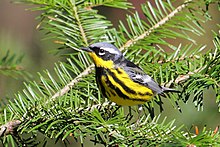Magnolia warbler
| Magnolia warbler | |
|---|---|
 |
|
| An adult male in Quebec | |
| Scientific classification | |
| Kingdom: | Animalia |
| Phylum: | Chordata |
| Class: | Aves |
| Order: | Passeriformes |
| Family: | Parulidae |
| Genus: | Setophaga |
| Species: | S. magnolia |
| Binomial name | |
|
Setophaga magnolia (Wilson, 1811) |
|
 |
|
| Range of the S. magnolia Breeding range Wintering range | |
| Synonyms | |
|
Dendroica magnolia |
|
Dendroica magnolia
Dendroica maculosa
The magnolia warbler (Setophaga magnolia) is a member of the wood warbler family Parulidae.
The genus name Setophaga is from Ancient Greek ses, "moth", and phagos, "eating", and the specific magnolia refers to the type locality. American ornithologist Alexander Wilson found this species in magnolias near Fort Adams, Mississippi.
This species is a moderately small New World warbler. It measures 11 to 13 cm (4.3 to 5.1 in) in length and spans 16 to 20 cm (6.3 to 7.9 in) across the wings. Body mass in adult birds can range from 6.6 to 12.6 g (0.23 to 0.44 oz), though weights have reportedly ranged up to 15 g (0.53 oz) prior to migration. Among standard measurements, the wing chord is 5.4 to 6.4 cm (2.1 to 2.5 in), the tail is 4.6 to 5.2 cm (1.8 to 2.0 in), the bill is 0.8 to 1 cm (0.31 to 0.39 in) and the tarsus is 1.7 to 1.85 cm (0.67 to 0.73 in). The magnolia warbler can be distinguished by its coloration. The breeding males often have white, gray, and black backs with yellow on the sides; yellow and black-striped stomachs; white, gray, and black foreheads and beaks; distinct black tails with white stripes on the underside; and defined white patches on their wings, called wing bars. Breeding females usually have the same type of coloration as the males, except that their colors are much duller. Immature warblers also resemble the same dull coloration of the females. The yellow and black-striped stomachs help one to distinguish the males from other similar birds, like the prairie warbler and Kirtland's warbler (which, however, have a breeding range to the south and east of the magnolia warbler's).
The magnolia warbler is found in the northern parts of some Midwestern states and the very northeastern parts of the US, with states such as Minnesota and Wisconsin comprising its southernmost boundaries. However, it is mostly found across the northern parts of Canada, such as in Saskatchewan, Manitoba, Ontario, and Quebec. During the winter, the warbler migrates through the eastern half of the United States to southern Mexico and Central America. The warbler breeds in dense forests, where it will most likely be found among the branches of young, densely packed, coniferous trees. The magnolia warbler migrates to the warmer south in the winter, wintering in southeastern Mexico, Panama, and parts of the Caribbean. In migration it passes through the eastern part of the United States as far west as Oklahoma and Kansas. During migration season, the magnolia warbler can be found in various types of woodlands.
...
Wikipedia

